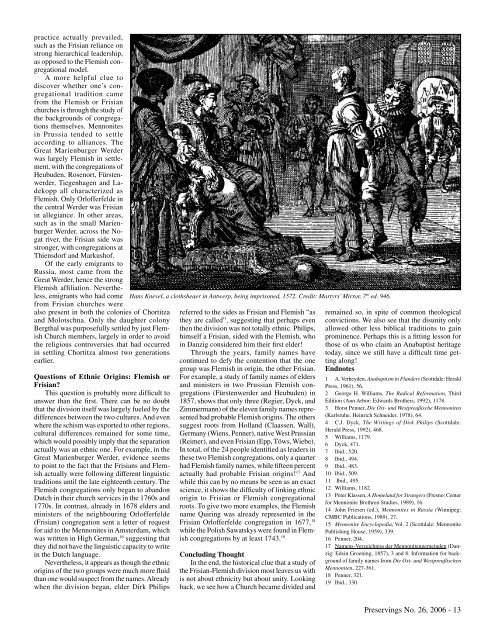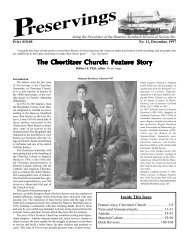Preservings $20 Issue No. 26, 2006 - Home at Plett Foundation
Preservings $20 Issue No. 26, 2006 - Home at Plett Foundation
Preservings $20 Issue No. 26, 2006 - Home at Plett Foundation
Create successful ePaper yourself
Turn your PDF publications into a flip-book with our unique Google optimized e-Paper software.
practice actually prevailed,<br />
such as the Frisian reliance on<br />
strong hierarchical leadership,<br />
as opposed to the Flemish congreg<strong>at</strong>ional<br />
model.<br />
A more helpful clue to<br />
discover whether one’s congreg<strong>at</strong>ional<br />
tradition came<br />
from the Flemish or Frisian<br />
churches is through the study of<br />
the backgrounds of congreg<strong>at</strong>ions<br />
themselves. Mennonites<br />
in Prussia tended to settle<br />
according to alliances. The<br />
Gre<strong>at</strong> Marienburger Werder<br />
was largely Flemish in settlement,<br />
with the congreg<strong>at</strong>ions of<br />
Heubuden, Rosenort, Fürstenwerder,<br />
Tiegenhagen and Ladekopp<br />
all characterized as<br />
Flemish. Only Orlofferfelde in<br />
the central Werder was Frisian<br />
in allegiance. In other areas,<br />
such as in the small Marienburger<br />
Werder, across the <strong>No</strong>g<strong>at</strong><br />
river, the Frisian side was<br />
stronger, with congreg<strong>at</strong>ions <strong>at</strong><br />
Thiensdorf and Markushof.<br />
Of the early emigrants to<br />
Russia, most came from the<br />
Gre<strong>at</strong> Werder, hence the strong<br />
Flemish affili<strong>at</strong>ion. Nevertheless,<br />
emigrants who had come<br />
from Frisian churches were<br />
also present in both the colonies of Chortitza<br />
and Molotschna. Only the daughter colony<br />
Bergthal was purposefully settled by just Flemish<br />
Church members, largely in order to avoid<br />
the religious controversies th<strong>at</strong> had occurred<br />
in settling Chortitza almost two gener<strong>at</strong>ions<br />
earlier.<br />
Questions of Ethnic Origins: Flemish or<br />
Frisian?<br />
This question is probably more difficult to<br />
answer than the first. There can be no doubt<br />
th<strong>at</strong> the division itself was largely fueled by the<br />
differences between the two cultures. And even<br />
where the schism was exported to other regions,<br />
cultural differences remained for some time,<br />
which would possibly imply th<strong>at</strong> the separ<strong>at</strong>ion<br />
actually was an ethnic one. For example, in the<br />
Gre<strong>at</strong> Marienburger Werder, evidence seems<br />
to point to the fact th<strong>at</strong> the Frisians and Flemish<br />
actually were following different linguistic<br />
traditions until the l<strong>at</strong>e eighteenth century. The<br />
Flemish congreg<strong>at</strong>ions only began to abandon<br />
Dutch in their church services in the 1760s and<br />
1770s. In contrast, already in 1678 elders and<br />
ministers of the neighbouring Orlofferfelde<br />
(Frisian) congreg<strong>at</strong>ion sent a letter of request<br />
for aid to the Mennonites in Amsterdam, which<br />
was written in High German, 16 suggesting th<strong>at</strong><br />
they did not have the linguistic capacity to write<br />
in the Dutch language.<br />
Nevertheless, it appears as though the ethnic<br />
origins of the two groups were much more fluid<br />
than one would suspect from the names. Already<br />
when the division began, elder Dirk Philips<br />
Hans Knevel, a clothsheaer in Antwerp, being imprisoned, 1572. Credit: Martyrs’ Mirror, 7 th ed. 946.<br />
referred to the sides as Frisian and Flemish “as<br />
they are called”, suggesting th<strong>at</strong> perhaps even<br />
then the division was not totally ethnic. Philips,<br />
himself a Frisian, sided with the Flemish, who<br />
in Danzig considered him their first elder!<br />
Through the years, family names have<br />
continued to defy the contention th<strong>at</strong> the one<br />
group was Flemish in origin, the other Frisian.<br />
For example, a study of family names of elders<br />
and ministers in two Prussian Flemish congreg<strong>at</strong>ions<br />
(Fürstenwerder and Heubuden) in<br />
1857, shows th<strong>at</strong> only three (Regier, Dyck, and<br />
Zimmermann) of the eleven family names represented<br />
had probable Flemish origins. The others<br />
suggest roots from Holland (Claassen, Wall),<br />
Germany (Wiens, Penner), n<strong>at</strong>ive West Prussian<br />
(Reimer), and even Frisian (Epp, Töws, Wiebe).<br />
In total, of the 24 people identified as leaders in<br />
these two Flemish congreg<strong>at</strong>ions, only a quarter<br />
had Flemish family names, while fifteen percent<br />
actually had probable Frisian origins! 17 And<br />
while this can by no means be seen as an exact<br />
science, it shows the difficulty of linking ethnic<br />
origin to Frisian or Flemish congreg<strong>at</strong>ional<br />
roots. To give two more examples, the Flemish<br />
name Quiring was already represented in the<br />
Frisian Orlofferfelde congreg<strong>at</strong>ion in 1677, 18<br />
while the Polish Saw<strong>at</strong>skys were found in Flemish<br />
congreg<strong>at</strong>ions by <strong>at</strong> least 1743. 19<br />
Concluding Thought<br />
In the end, the historical clue th<strong>at</strong> a study of<br />
the Frisian-Flemish division most leaves us with<br />
is not about ethnicity but about unity. Looking<br />
back, we see how a Church became divided and<br />
remained so, in spite of common theological<br />
convictions. We also see th<strong>at</strong> the disunity only<br />
allowed other less biblical traditions to gain<br />
prominence. Perhaps this is a fitting lesson for<br />
those of us who claim an Anabaptist heritage<br />
today, since we still have a difficult time getting<br />
along!<br />
Endnotes<br />
1 A. Verheyden, Anabaptism in Flanders (Scottdale: Herald<br />
Press, 1961), 56.<br />
2 George H. Williams, The Radical Reform<strong>at</strong>ion, Third<br />
Edition (Ann Arbor: Edwards Brothers, 1992), 1178.<br />
3 Horst Penner, Die Ost- und Westpreußische Mennoniten<br />
(Karlsruhe, Heinrich Schneider, 1978), 64.<br />
4 C.J. Dyck, The Writings of Dirk Philips (Scottdale:<br />
Herald Press, 1992), 468.<br />
5 Williams, 1179.<br />
6 Dyck, 471.<br />
7 Ibid., 520.<br />
8 Ibid., 494.<br />
9 Ibid., 483.<br />
10 Ibid., 509.<br />
11 Ibid., 495.<br />
12 Williams, 1182.<br />
13 Peter Klassen, A <strong>Home</strong>land for Strangers (Fresno: Center<br />
for Mennonite Brethren Studies, 1989), 16.<br />
14 John Friesen (ed.), Mennonites in Russia (Winnipeg:<br />
CMBC Public<strong>at</strong>ions, 1989), 27.<br />
15 Mennonite Encyclopedia, Vol. 2 (Scottdale: Mennonite<br />
Publishing House, 1959), 339.<br />
16 Penner, 204.<br />
17 Namens-Verzeichniss der Mennonitengemeinden (Danzig:<br />
Edsin Groening, 1857), 3 and 8. Inform<strong>at</strong>ion for background<br />
of family names from Die Ost- und Westpreußischen<br />
Mennoniten, 227-361.<br />
18 Penner, 321.<br />
19 Ibid., 330.<br />
<strong>Preservings</strong> <strong>No</strong>. <strong>26</strong>, <strong>2006</strong> - 13
















